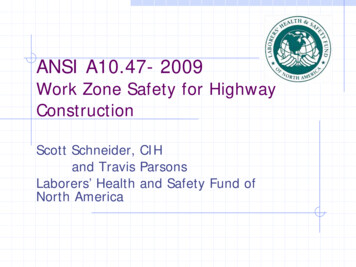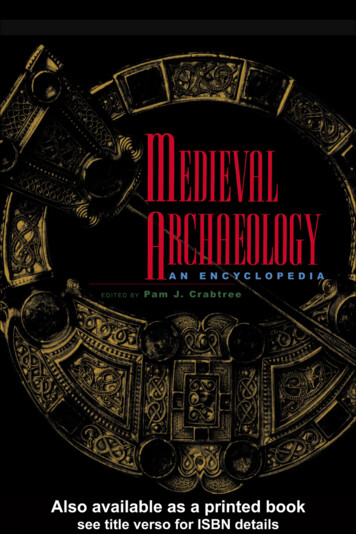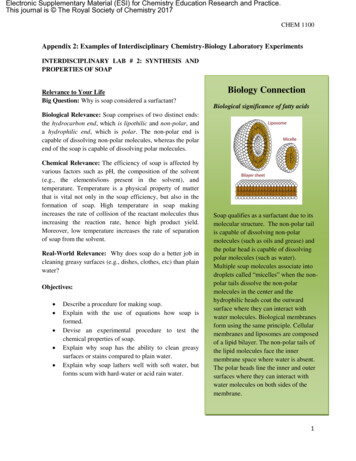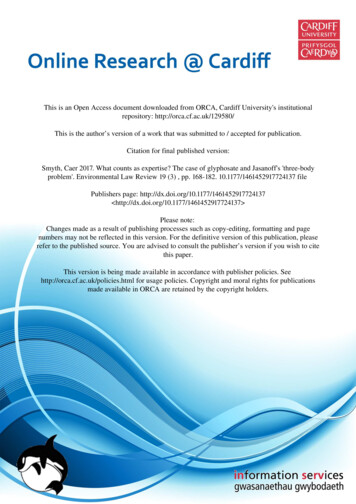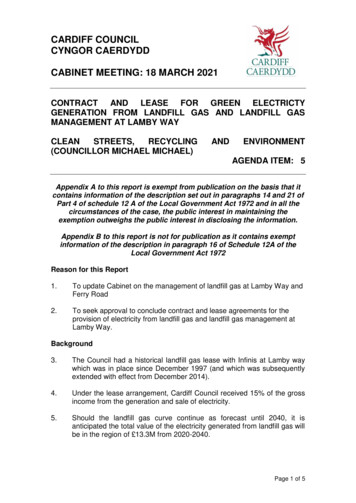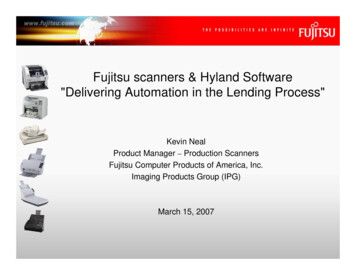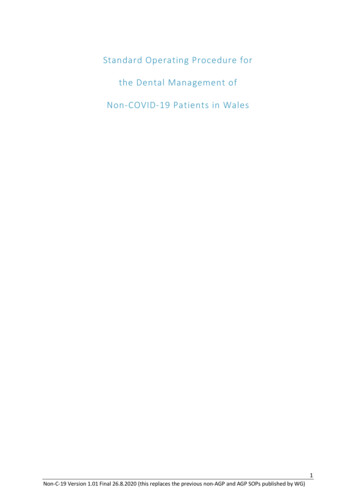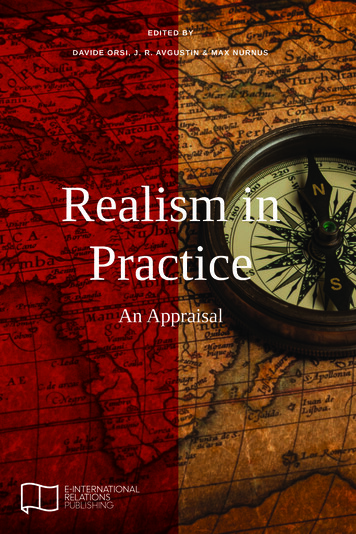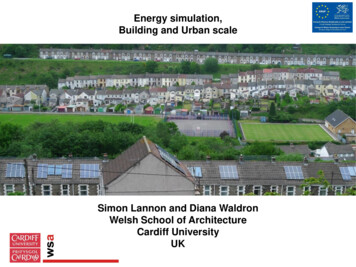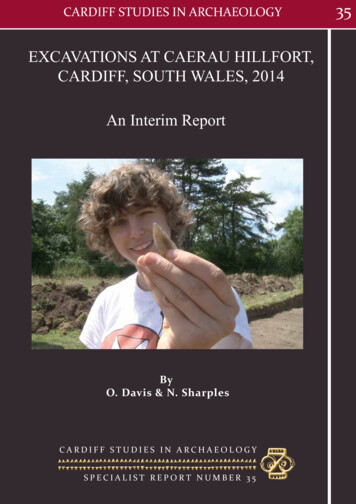
Transcription
CARDIFF STUDIES IN ARCHAEOLOGYEXCAVATIONS AT CAERAU HILLFORT,CARDIFF, SOUTH WALES, 2014An Interim ReportByO. Davis & N. SharplesCARDIFF STUDIES IN ARCHAEOLOGYSPECIALIST REPORT NUMBER 3535
EXCAVATIONS AT CAERAU HILLFORT,CARDIFF, SOUTH WALES, 2014Interim ReportbyO. Davis & N. Sharpleswith contributions byM. Allen, P. Hodkinson & R. MadgewickCARDIFF STUDIES IN ARCHAEOLOGYSPECIALIST REPORT NUMBER 35
EXCAVATIONS AT CAERAU HILLFORT,CARDIFF, SOUTH WALES, 2014National Primary Reference Number (NPRN) 94517Cadw Scheduled Ancient Monument No. GM018Cardiff Studies in Archaeology Specialist Report 35 The authors 2015Oliver Davis and Niall Sharples,ISBN 978-0-9568398-4-8Published by the Department of Archaeology & ConservationSchool of History Archaeology and ReligionCardiff University,John Percival Building,Colum Drive,Cardiff,CF10 3EUTel: 44 (0)29 208 74470Fax: 44 (0)29 208 74929Email: adminshare@cardiff.ac.ukAll rights reserved. No part of this publication may be reproducedin any form or by any means without permission of the authors.Designed by Cardiff Archaeological Illustration and DesignSoftware: Adobe Creative Suite 6 Design Premium
Contents1. Introduction 12. Background 33. Previous Archaeological Work 74. Project Aims & Objectives 95. Excavation Methodology 136. Excavation Results 157. Finds 538. Palaeo - Environmental Summary 599. Summary 7310. Community Impact 7511. Bibliography 97Appendix 1- Context Lists 91Appendix 2 - Small Find List 97Appendix 3 - Sample List 99
1. IntroductionFour weeks of excavation at Caerau Hillfort (NPRN94517; SAM GM018) were carried out from 30 June to 25July 2014 and involved the excavation of four trenches.This work is the second season (see Davis and Sharples2014 for detailed discussion of the 2013 excavations) ofan initial proposed first-stage evaluation to characterisethe occupation of the hillfort. It is intended that this workwill provide significant new information about the natureof Iron Age occupation and daily life within hillforts andestablish a chronological framework for their occupationin south-east Wales. In addition, the investigation ofRomano-British features at Caerau, some of potential‘invasion period’ date, as well as Medieval features, willsignificantly add to our knowledge of these importantperiods in south-east Wales. Significantly, this year’sexcavations have revealed complex Neolithic activity onthe hill with the identification of a possible causewayedenclosure defined by four lines of ditches. Such adiscovery is of national significance – only five othercausewayed enclosures are known in Wales, three in theVale of Glamorgan (Norton, Corntown, Flemingston), onein Powys (Womaston) and one in Pembrokeshire (BancDu). There are also four other 'possibles' known fromaerial photography, Dryslwyn (Pembrokeshire), MarianFfrith (Denbighshire), Weaver’s Plantation (Powys),Little Norton (Vale of Glamorgan), but these are far fromcertain and could well be later prehistoric.permission to carry out the investigations. The woodedboundary earthworks of the hillfort are owned by CardiffCouncil and our thanks are extended to Nicola Hutchinsonand her colleagues at Cardiff Council Park Services forallowing us to extend Trench 3 and Trench 9 into thisarea. The area is a Scheduled Ancient Monument andScheduled Monument Consent was granted by Cadw andwe are grateful to Jon Berry and his colleagues at Cadwfor their continuing support. Funding for the excavationswas provided by the Arts and Humanities ResearchCouncil and Cardiff University.The project was directed by Dr Oliver Davis, ProfessorNiall Sharples and Dr David Wyatt of Cardiff University.The core project team consisted of 13 staff and 21 studentarchaeologists from Cardiff University. From the outsetthe Caerau excavations have linked nationally significantresearch with a broad mission to engage with the public,particularly the local communities of Caerau and Ely.The engagement strategy this year was again to raise thepublic’s awareness of, and participation in, local heritageand archaeological fieldwork, providing educationalopportunities and widen access to further education. Theaim was to challenge stigmas and unfounded stereotypesascribed to this part of Cardiff. The excavation alsoprovided an excellent opportunity to involve 21undergraduate students and numerous volunteers inknowledge transfer and community engagement activitiesthat will provide them with significant employabilityskills.A selection of radiocarbon samples is currently pendingan application to NERC in April 2015. Mike Allen,AEA, undertook further environmental assessment ofthe soils and we are pleased to include a summary ofhis second report in this interim. We would also liketo thank Tim Young, Ian Dennis, Rob Thomas and SueVirgo for their logistical support. Particular thanks shouldgo to Dave Horton, Taela-May Hindle and all theircolleagues at Action Caerau and Ely for their support andencouragement.This report summarises the results of the excavations andincludes the stratigraphic sequences recorded in each ofthe four trenches, and a discussion of the excavation’ssignificance for understanding hillforts and causewayedenclosures in south-east Wales. The animal bone reportwas undertaken by Dr Richard Madgwick and Ms PoppyHodkinson, Cardiff University. A detailed analysis of theCaerau glass bead, recovered from Trench 4 during the2013 excavations has been completed by Dr ElizabethFoulds, Durham University. The other specialist findsand palaeo-environmental reports are currently inpreparation and only brief summaries are provided here.All of the drawings were completed by Katie Sutton andAlice Bertini under the guidance of Ian Dennis and KirstyHarding and we are extremely grateful to them all.Finally, we would like to thank the numerous membersof the local community who gave their time anddemonstrated amazing passion and interest for theirlocal heritage – none of this work would have beenpossible without their help and support. A summary ofthe community engagement activities is provided here.The interior of the hillfort is privately owned and we arevery grateful to the David family of Penylan Farm for1
2. Backgroundand the National Museum of Wales to involve youngpeople facing exclusion in creating a heritage themed art;community outreach opportunities for university studentsworking closely alongside community participants.2.1 Background of CAER Heritage ProjectA summary of the CAER Heritage Project was providedin the 2013 interim report (Davis and Sharples 2014)and an analysis of the impact of the project has beenundertaken (Ancarno et al. forthcoming). However, amore reflective summary is offered here.The wide ranging nature of the project's impacts,partnerships and the embedding of academics and aprofessional artist within a community context resultedin multifarious, often 'organically' nurtured forms ofengagement and co-production. This included theembedding of research co-production within the curriculaof participating secondary schools with pupils undertakinggeophysical surveys, archaeological excavation, creatingmuseum exhibitions, performances and artwork, heritagetrails and participating in a Timeteam programme in April2012. The involvement of professional artist, Paul Evans,in all stages of the project proved a particularly successfulstrategy in this respect. Paul designed and facilitatedcreative forms of engagement with local heritage themesincluding large eco-graffiti art installations, puppetshows, heritage trail design and the creation of an IronAge themed mural with both local pupils in mainstreamsecondary education and young people excluded fromschool. Furthermore, the embedding of research withina series of free accredited adult-education courses inpractical archaeology, in association with Cardiff Centrefor Lifelong Learning, proved successful in engaginglong term unemployed males in co-production – withclear benefits in terms of progression and confidencebuilding for a number of individuals (Davis and Sharples2014, 59-60)Funded by the Arts and Humanities Research Council,the Caerau And Ely Rediscovering (CAER) HeritageProject is a collaborative project begun in 2011 betweenCardiff University, Action in Caerau and Ely (a charitythat runs the Community First Programme), local schoolsand local residents. The project is based around one ofCardiff’s most important, but little-known, archaeologicalsites, Caerau Hillfort, and seeks to engage local peopleand school children in their shared history and challengemarginalisation.In synergy with the practices of our partner communitydevelopment organisation, Action in Caerau and Ely(ACE), the CAER Heritage team are committed toinvolving community members actively in the coproduction of research; valuing the contribution ofall participants and partners in a mutually beneficialand reciprocal relationship. To date, the project hasinvolved a myriad of non-HE partners (primary andsecondary schools, community groups, youth workers,community development workers, local residents, theNational Museum of Wales, Cardiff Story Museum,Glamorgan Archives, Cardiff Council etc.) alongsideacademics, undergraduates and postgraduates from arange of disciplines at Cardiff University (e.g. history,archaeology, social sciences).The CAER Heritage Project has also sought to establishnew social and professional partnerships therebycreating a new ‘community of practice’ (Hart et al.2012). A crucial ingredient in this creation was theequal value placed on the contributions and ‘knowledgebase’ of all partners, whether trained professional orcommunity volunteers (Hart et al. 2012, 6). Fromthe outset, community members, secondary schoolsand community development agencies have beenintegrated in the project’s development. This includesthe establishment of a ‘Friends of Caerau’ communitygroup which continues to meet bi-monthly and organiseslitter picks, trail clearances and heritage events. It alsoincludes the establishment of a special partnership withthe management team at two local secondary schools,Glyn Derw and Michaelston Community College, whoembedded aspects of local heritage into the curriculum.Excavation at Caerau Hillfort has been an incrediblyimportant aspect of the project’s success, as it providesthe focus for intensive and wide-ranging engagementwith local communities. However, it should only beconsidered as a single part of a suite of activities andstrategies employed to ensure meaningful co-productionand mutual benefit between the wide range of academic,heritage sector and community partners involved. Theseinclude: community consultation and involvement infunding bids; the embedding of an academic memberof staff (Oliver Davis) within ACE; the developmentof a close partnership with local secondary schools; theestablishment of community-based adult learners courses;the creation of partnerships with a local youth centre3
Davis & SharplesMoreover, the CAER Heritage Project has grown fromrelatively humble beginnings in 2011 to become oneof the key community projects of partner organisationACE. ACE is a community based organisation whichaims to support the social, economic and environmentalregeneration of Ely and Caerau. ACE staff worked withthe university staff, every step of the way, to plan thedevelopment of the CAER Heritage Project; providingaccess to a network of local community groups enablingthe involvement of local residents in project activities.ACE facilitated further funding grant successes (e.g. HLFAll Our Stories) and ensured that CAER was integratedinto, and benefited from, 'Timeplace' (Ely and Caerau'stimebank). ACE therefore brings incredible assets to theproject, most notably the trust and networks that theyhad built up over years with local people and communitygroups, but also a deep knowledge of the area and aninsightful understanding of the challenges faced by thesecommunities.the western tip of an extensive plateau, now cut throughby the A4232, in western Cardiff (Figure 1). The northernand southern boundaries are defined by three banks andditches, whereas the east side is defined by a single massivebank and ditch, which is penetrated by two inturnedentrances; these enclose a triangular area of 51,000 m².The parish church, St. Mary’s (13th century), and a smallringwork, are located in the north-eastern corner of thehillfort and have resulted in a substantial modification ofthe earthworks. The entire area is a Scheduled AncientMonument, apart from the church, which is a Grade IIListed Building. The OS 2nd edition map also showsa vicarage or small farmhouse to the south-west of thechurch, which is now largely destroyed (Figure 2).The site is situated c. 70-80 m OD at the western end ofa broad ridge of land that drops off steeply to the west,north and south. The highest point of the ridge is actuallyc. 1,800 m east of Caerau Hillfort on Cock Hill. To thesouth of the hillfort, a small stream (Bullcroft Brook)winds its way to Dinas Powys. To the north of the fort isa flat lowland plain leading to the banks of the river Ely.Land to the south-west is slightly steeper, and the remainsof a possible prehistoric field system are evident here onTwyn Bwmbegan at NGR ST 1229 7417.An important aspect of the project has been to maintainparticipation in the research process by non-academicsbeyond the end of the excavation. Indeed, studies on coproduction and community partnership have identifiedthe need for ‘continuing involvement’ and ‘the sustainedpursuit of a shared enterprise’ (Boyle and Harris 2009, 16;Hart et al. 2012, 4). For the 2013 and 2014 excavationsthis was achieved through the ongoing involvement inthe analysis of the finds recovered – for example adultlearner’s courses entitled ‘Conserving Caerau’s Finds’provided the opportunity for community members toconduct their own guided research into the artefactsderived from the excavation. They then producedposters which have been displayed at CAER events andincorporated into a published booklet on the excavations.Community participants have also been at the forefront ofa ‘roaming museum’ – this has involved the presentationand display of artefacts recovered from the excavations atlocations throughout Caerau and Ely and wider Cardiff.This has provided people with a ‘hands-on’ opportunityto engage with their heritage and, importantly, to engagewith their fellow residents who have been involved in theproject, helping to build confidence and encourage peerto-peer learning.The earthwork boundaries defining the site are someof the largest and most complex in south Wales and adetailed analysis of the surviving structural remains isavailable in the 2013 interim report (Davis and Sharples2014).2.3 Geology of the siteThe solid geology is Triassic in age and formed ofMercia Mudstone (New Red Sandstone). The geologyis essentially arranged horizontally – the lower part ofthe hill is made up of undifferentiated Mercia MudstoneGroup dominated by reddish claystones and siltstones(Keuper Marl), whilst the upper part is the Blue AnchorFormation, dominantly grey-green claystone andsiltstones (Tea-green marls). The weathering of theseTea-green marls provides the sticky grey clays apparentwithin the western and northern areas of the hillfort. Thetop of the hill has a small, thin, capping of boulder claydeposited during the last glaciation and draped over theBlue Anchor Formation. The junction of this boulderclay and Blue Anchor Formation is the location of aspring line on the hilltop.The impact of the work of the CAER Heritage Projectwas recognised in June 2014 when it was declared theoverall winner out of 230 entries in the National Coordinating Centre for Public Engagement’s (NCCPE)UK-wide ‘Engage Competition’, which celebrates publicengagement projects.2.2 Description of the siteCaerau Hillfort is situated at NGR ST13377489 and is amultivallate hillfort covering a total area, including thehillfort boundaries, of 88,400 m². The hillfort occupies4
BackgroundFig. 1. Location map of Caerau HillfortFig. 2. Ordnance Survey 2nd Edition map (c. 1900)5
3. Previous Archaeological Work3.1 Earthwork, LiDAR and geophysicalsurveys3.2 ExcavationsIn April 2012 Channel Four’s Time Team undertook asmall archaeological evaluation of the hillfort (WessexArchaeology 2013). Six small trenches were opened(Figure 3) and revealed evidence for a range of Iron Age,Romano-British and Medieval/post-Medieval activity onthe hill. In particular, this included occupation and ironworking activity.A topographic earthwork survey of the hillfort wasconducted in 1976 by the RCAHMW for their GlamorganInventory (RCAHMW 1976). Further archaeologicalinvestigation was not then conducted until 2011 when aLiDAR survey, commissioned by Cadw, RCAHMW andNational Museum Wales, was undertaken as part of the StFagans Historic Landscape Project led by Mark Redknap,National Museum Wales. Subsequently, in March 2012,a magnetometry and resistivity survey was undertakenwithin the interior of the hillfort (Young 2012) as partof a community engagement project organised by theCAER Heritage Project. Further geophysical survey wascarried out over an approximate area of 50,000 m² usinga fluxgate gradiometer by GSB Prospection Ltd in April2012 as part of the Time Team investigations. All ofthese surveys were discussed in detail in the 2013 interim(Davis and Sharples 2014) and will not be repeated here.In June and July 2013, the CAER Heritage Projectopened three trenches directly overlying Time Team’strenches 3, 4 and 5, in order to recover a large assemblageof finds material to further date and characterise theidentified features. The results of those excavations aredescribed in detail in the 2013 interim report (Davis andSharples 2014). Combined with the excavations in 2014,a total area of 1,130 m² has now been excavated withinthe interior of the hillfort and a further 30 m² across thehillfort boundaries. This represents a sample of 1.3 % ofthe entire monument.Fig. 3. Location of all trenches (2012-2014)7
4. Project Aims & Objectives4.1 Research aims summaryhillfort architecture and associated material culture,which needs to be addressed.The recent LiDAR and geophysical surveys, combinedwith the Time Team excavations, although of considerableresearch value, have provided us with only a very smalldataset on which to base our interpretation of the site.Furthermore, the Time Team excavations were by theirnature time restricted not allowing the full excavationor understanding of features and structures partiallyidentified. This has left many unanswered questionsconcerning the nature, use and duration of activity at thesite. No aspect of the medieval story of the hill has so farbeen explored by invasive or non-invasive methods.The lack of substantial assemblages of environmentalremains from hillforts is also problematic and meansthat questions about Iron Age agricultural regimes – howthe daily work schedule was arranged and how it variedwith the seasonal cycle – are not clear. Work by MartinBell on the Severn Levels (Bell et al. 2000) has identifiedtemporary camps connected with seasonal movements ofpeople and animals, but how these wetland sites relate tothe dryland occupation of hillforts is not well understood.Most of our knowledge of Iron Age daily life thereforecomes from excavations at smaller, non-hillfort,settlements. Large area excavations at Mynydd Bychan(Savory 1954; 1955), Coed y Cymdda (Owen-John1988), Whitton (Jarrett and Wrathmell 1981) and CaeSummerhouse (Davies 1966) have revealed coherentinterior plans, although the latter remains unpublished.Yet the relationship of the occupation and use of thesesettlements with the occupation and use of hillforts isnot clear. In particular, the construction of Late IronAge rectilinear enclosures such as at Cae Summerhouse(Davies 1966), Whitton (Jarrett and Wrathmell 1981)and possibly Ely (Young 2001) hint at the emergenceof a class of high-status settlement at a time in the firstcentury AD when the continued use and elaboration ofhillforts is not well understood. Some non-hillfort siteswere continuously occupied from the Iron Age into theRoman period (e.g. Biglis; Robinson 1988, xi) and morethan half of the excavated hillforts have produced someevidence for Romano-British activity (Gwilt 2007, 299300) although this may have been due to reoccupationrather than continuous use.4.1.1 Research contextStrong regional variations in hillfort sizes have longbeen recognised in Wales and the Marches (Hogg 1972).Iron Age and Roman settlement within the old countyof Glamorgan has been subject of a RCAHMW survey(1976) although Gwent has not. More recent surveys bythe Glamorgan and Gwent Archaeological Trust (Evans2001; 2002; Evans et al. 2006) have identified more than130 hillforts within the region of south-east Wales andfurther defined their morphological diversity. However, itis one thing to be able to locate hillforts and describe theirmorphology, yet quite another to fix their construction,development and occupation through time.Previous accounts have tended to see the hillforts ofsouth-east Wales as late arrivals (Davies and Lynch2000; Savory 1976) in contrast to Late Bronze Agebeginnings in north and west Wales. Yet, too few havebeen excavated on a sufficient scale to support a crediblepicture or chronology for the region. Only Twyn-y-Gaer,in northern Gwent (Probert 1976) has seen large-areaexcavations of boundaries and interior, although the fullreport remains unpublished. Small-scale excavationshave established local sequences and recovered findsassemblages at Llanmelin, Monmouthshire (NashWilliams 1933), Sudbrook, Monmouthshire (Sell 2001),Lodge Wood Camp, Newport (Howell and Pollard2000), Castle Ditches, Llancarfan (Hogg 1976) andCaer Dynnaf, Llanblethian (Davies 1967). Only eightradiocarbon dates from three hillforts in the region existin the literature (Gwilt 2007, 298). This leaves a weakchronological framework, dependent upon comparativeThe excavations at Caerau Hillfort therefore providethe opportunity to explore these issues through coproduced research with the community. In particular, animportant chronological framework will be establishedand questions about the nature of Iron Age occupationand daily life addressed. In addition, the investigationof Romano-British features at Caerau, some of potential‘invasion period’ date, will significantly add to ourknowledge of this important time in south-east Wales.The subjugation of the Welsh tribes, particularly theSilures, took about thirty years in the face of stubborn9
Davis & Sharplesresistance and is well documented by the Roman authorTacitus (Annales XII). These excavations will thereforeallow for the examination of interesting questions aboutpower relations, Roman control and native-Romanacculturation in this region during the first century AD.vast majority of Neolithic causewayed enclosures arelocated in southern England and our knowledge of thesehas been significantly advanced in recent years throughan intensive program of radiocarbon dating (Whittle etal. 2011). However, in Wales fewer than ten causewayedenclosures are known or suspected and our understandingof their dating and use is very limited. Small-scaleexcavations at Banc Du, Pembrokeshire, produced nocultural material (Darvill et al. 2007) while excavationsby GGAT at Norton, Vale of Glamorgan, produced postMedieval radiocarbon dates (Lewis and Huckfield 2009).Only excavations at Womaston, Powys, have producedcultural material in association with early Neolithicradiocarbon dates (Jones 2009), although the potteryassemblage was very small (14 sherds). Therefore, thedating of radiocarbon samples from Caerau, combinedwith the analysis of the pottery and flint assemblage willsignificantly enhance our understanding of these earlyNeolithic monuments in Wales.The ringwork at Caerau is an oval bank and ditchenclosure, 52 m by 34 m, sited in the north-east cornerof the hillfort. It is not historically documented but hasbeen identified as a ‘castle-ringwork’ of early Normandate on typological grounds (Cathcart, King and Alcock1969; Spurgeon 1987), an identification restated bythe RCAHMW in their volume on the Early Castles ofGlamorgan (1991, 86-9). As such it fits into a substantialand interesting group of such monuments in the southernVale of Glamorgan (RCAHMW 1991, 31-46, figs9-11). The presence of the adjacent church of St Mary’scontributes to the identification and, on the basis that thechurch was originally a chapel of the bishops of Llandaf,the earthwork is suggested to have been an Episcopalcastle (RCAHMW 1991, 87-9).4.1.2 Overall research aimsThe only apparent dating evidence for the ringwork is asherd of ‘12th century’ pottery (RCAHMW 1991, 87) andrecent work at Llanfor, Gwynedd has raised the possibilityof a pre-Norman date for some such earthworks (BurkeDavies 2011). Confirmation of the date of the Caerausite and its Norman attribution would be a valuableexercise in itself. Geophysics might reveal evidence oftimber or masonry structures comparable to those knownfrom excavations at Penmaen, Pennard, Llantrithyd, allGlamorgan, and Rumney, Gwent (RCAHMW 1991,43-6). The possibility of a gate tower in the entranceas known from Penmaen could also be a target forgeophysics or excavation (Alcock 1966).At the start of the 2014 season the long term aims of thisresearch were: St Mary’s church is set south-east from, and adjacent to,the ringwork. The church is first documented in the 13thcentury as a chapel of Llandaf, though it became a parishchurch after the Reformation (RCAHMW 1991, 86-9).The building includes elements of early 14th century and16th century date. There is no evidence of a pre-Normanchurch on the site. Brook identified the church enclosureas nearly circular in its earliest 1841 Tithe plan (Brook1992). This might support the idea of a pre-Normanfoundation with a reported holy well – ‘saint well’ southwest of the church - though this suggestion is tentative.There is good evidence from both Cornwall and Wales thatcircularity is a feature of many pre-Norman churchyardsthough not all curvilinear churchyards are of this date(Brook 1992). In the absence of correlating evidence suchas pre-Norman sculpture or a Welsh church dedicationany suggestion of a pre-conquest origin must be regardedas tentative. The acquisition of dating evidence for thechurch or its enclosure would be desirable. To understand the development of a mulitvallatehillfort from the Late Bronze Age to Roman periodin south-east WalesTo understand the pattern of occupation andorganisation of activities within the interior of ahillfort and how this changed over timeTo better understand the social and economic life ofthe inhabitants of the hillfort and the regionTo understand the significance of the RomanoBritish occupation of the hillfortTo confirm the date of construction of the ringworkand the survival of internal features including agatehouseTo understand the chronological and structuralrelationship, if any, between the ringwork and StMary’s churchTo establish a chronological framework for the laterprehistoric, Roman and Medieval activity on the siteTo understand how Caerau relates to the surroundingsettlement landscapeThese aims directly address three of the research themesidentified in the Later Bronze Age and Iron Age ResearchFramework for the Archaeology of Wales (www2):Chronology, Settlement and land-use and Processes ofchange, and two in the Medieval Research Frameworkfor the Archaeology of Wales (www3): Settlement andLand-use.With the identification of the Neolithic activity, theoverall aims will also now need to address the researchthemes identified in the Neolithic and Early BronzeAge Research Framework for the Archaeology of WalesThe identification of a Neolithic enclosure on the hill in2014 was unexpected and is of considerable interest. The10
Aims & Objectives(www4): The development, role and use of monumentsand the Later Mesolithic to Early Neolithic transition.This would include:It was also considered that further features may becomemore apparent after a period of exposure to the elements.The principal identified issues to be resolved are: Trench 1 – The ditch was not satisfactorily dated withthe only chronological indicator being a possibly residualquern fragment. The analysis of palaeo-environmental remains toestablish environmental contextTo establish a chronology for the construction, useand abandonment of the Neolithic enclosureTo understand the nature and use of Neolithicmaterial cultureTrench 2 – The features identified were interpreted asa four-post structure. A larger area could be openedhere to ascertain whether this structure was correctlycharacterised.4.2 Research objectives of 2014 excavationsTrench 3 – The excavations revealed the existence ofa well-defined house but not enough was exposed tocharacterise and understand the construction, use andabandonment of the house. The discovery of Early IronAge ceramics is very important and further work needs tobe done to assess the extent of the activity of this date andits relationship to the use and occupation of the house.In order to realise these overall aims there is a twostage research plan (see Davis and Sharples 2013 forfull research plan and objectives). The excavations in2013 and 2014 form part of Stage 1 designed to meet thefollowing objective:Objective: Further examine and characterise the featuresidentified by the Time Team excavations (WessexArchaeology 2013).Trench 4 – The area opened was not large enough tounderstand the gateway into the enclosure. The ditchterminals contained dateable ceramics and the fullexcavation of both terminals should provide sufficientmaterial to accurately date the creation of this Late IronAge or Early Roman enclosure.Six trenches were exc
Software: Adobe Creative Suite 6 Design Premium EXCAVATIONS AT CAERAU HILLFORT, CARDIFF, SOUTH WALES, 2014 National Primary Reference Number (NPRN) 94517 Cadw Scheduled Ancient Monument No. GM018. Contents 1. Introduction 1 2. Background 3 3. Previous Archaeological W

